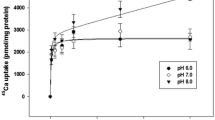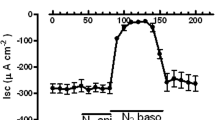Abstract
Isolated posterior gills (no. 7) of shore crabsCarcinus maenas acclimated to brackish water of a salinity of 10 S were bathed and perfused with 50% sea water (200 mmol·l-1 Na+), and the internal perfusate collected during subsequent periods of 5 min. During a single passage through the gill the pH of the perfusion medium decreased from ca. 8.1 to ca. 7.7, a result implying that the gill possesses structures which “recognize” unphysiologically high pH values in the haemolymph and regulates them down to physiological values of ca. 7.7. The calculated apparent proton fluxes from the epithelial cells into the haemolymph space amounted to 17.9 μmol·g fw-1·h-1, a value of only 3.8% of net Na+ fluxes observed under comparable conditions. When 0.1 mmol·l-1 KCN, an inhibitor of mitochondrial cytochrome oxidase, or 5 mmol·l-1 ouabain, a specific inhibitor of Na+/K+-ATPase were applied in the internal perfusate, down-regulation of pH was no longer observed and the gill was completely depolarized, i.e. transepithelial potential differences dropped from-7.8 to 0 mV (haemolymph space negative to bath). Regulation of pH was completely inhibited by antagonists of carbonic anhydrase (0.1 mmol·l-1 acetazolamide or 0.01 mmol·l-1 ethoxyzolamide) applied in the perfusate. Inhibitors of Na+/H+ exchange, 0.1 mmol·l-1 amiloride applied in the external bathing medium or in the internal perfusate, and symmetrical 0.01 mmol·l-1 5-(N-ethyl-N-isopropyl)amiloride, as well as inhibitors of Cl-/HCO3 - exchange and Na+/HCO3 - cotransport, 0.5 mmol·l-1 4,4′-diisothiocyanatostilbene-2,2′-disulphonate or 0.3 mmol·l-1 4-acetamido-4′-isothiocyanatostilbene 2,2′-disulphonate applied on both sides of the gill, and inhibitors of H+-ATPase, 0.05 mmol·l-1 N-ethylmaleimide and 0.1 mmol·l-1 N,N′-dicyclohexylcarbodiimide —applied on both sides of the gill — did not alter the acidification of the perfusate observed in controls. Using artificial salines buffered to pH 8.1 with 0.75 mmol·l-1 tris (hydroxymethyl) aminomethane instead of 2 mmol·l-1 HCO3 -, apparent proton fluxes were reduced to 11% of controls, a result suggesting that pH regulation by crab gills needs the presence of HCO3 -. The findings obtained suggest that pH regulation by crab gills depends on the oxidative metabolism of the intact branchial epithelium and that carbonic anhydrase plays a central role in this process. Na+/H+ exchange, anion exchange or cotransport and active proton secretion seem not to be involved. While unimpaired active ion uptake is a prerequisite for pH regulation, ion transport itself is independent of it.
Similar content being viewed by others
Abbreviations
- acetazolamide:
-
(N-[sulphamoyl-1, 3, 4-thiadiazol-2-yl]-acetamide)
- amiloride:
-
3,5-diamino-6-chloropyrazinoyl-guanidine
- CA:
-
carbonic anhydrase
- DBI:
-
dextrane-bound inhibitor thiadiazolesulphonamide
- DCCD N:
-
N′ dicyclohexylcarbodiimide
- DIDS:
-
4,4′-diisothiocyanato-stilbene-2,2′-disulphonate
- EIPA:
-
5-(N-ethyl-N-isopropyl) amiloride
- ethoxyzolamide:
-
6-ethoxy-2-benzothiazole-sulphonamide
- fw:
-
fresh weight
- J H + :
-
apparent proton flux
- NEM:
-
N-ethylmaleimide
- PD:
-
transepithelial potential difference
- PEG-STZ:
-
polyethylene-glycol-thiadiazolesulphonamide
- STTS:
-
4-acetamido-4′-isothiocyanatostibene 2,2′-disulphonate
- SW:
-
sea water
- TRIS:
-
tris(hydroxymethyl)aminomethane
References
Böttcher K, Siebers D (1993) Biochemistry, localization and physiology of carbonic anhydrase in the gills of euryhaline crabs. J Exp Biol 265:397–409
Böttcher K, Siebers D, Becker W, Petrausch G (1991) Physiological role of branchial carbonic anhydrase in the shore crabCarcinus maenas. Mar Biol 110:337–342
Burnett LE (1984) CO2 excretion across isolated crab gills: facilitation by carbonic anhydrase. Am Zool 24:253–264
Burnett LE, McMahon BR (1985) Facilitation of CO2 excretion by carbonic anhydrase located in the surface of the basal membrane of crab gill epithelium. Respir Physiol 62:341–348
Burnett LE, Woodson PBJ, Rietow MG, Villicich VC (1981) Crab gill intra-epithelial carbonic anhydrase plays a major role in haemolymph CO2 and chloride ion regulation. J Exp Biol 92:243–254
Henry RP, Wheatly MG (1992) Interaction of respiration, ion regulation, and acid-base balance in the everyday life of aquatic crustaceans. Am Zool 32:407–416
Hölleland T, Towle DW (1990) Vanadate but not ouabain inhibits Na++K+-ATPase and sodium transport in tight inside-out native membrane vesicles from crab gill (Carcinus maenas). Comp Biochem Physiol 96B:177–181
Kirschner LB (1979) Control mechanisms in crustaceans and fishes. In: Gilles R (ed) Mechanisms of osmoregulation in animals. Wiley, Chichester pp 157–222
Kormanik GA, Cameron JN (1981) Ammonia excretion in animals that breath water: review. Mar Biol Lett 2:11–23
Lucu C (1989) Evidence for Cl- exchangers in perfusedCarcinus gills. Comp Biochem Physiol 92A:415–420
Lucu C (1990) Ionic regulatory mechanisms in crustacean gill epithelia. Comp Biochem Physiol 97A:297–306
Onken H, Siebers D (1992) Voltage-clamp measurements on single split lamellae of posterior gills of the shore crabCarcinus maenas. Mar Biol 114:385–390
Perry SF, Laurent P (1990) The role of carbonic anhydrase in carbon dioxide excretion, acid-base-balance and ionic regulation in aquatic gill breathers. In: Kinne RKH (ed) Comparative Physiology, vol 2. Karger, Basel, pp 39–57
Siebers D, Leweck K, Markus H, Winkler A (1985) Sodium regulation in the shore crabCarcinus maenas as related to ambient salinity. Mar Biol 69:37–43
Siebers D, Lucu C, Winkler A, Dalla Venezia L, Wille H (1986) Active uptake of sodium in the gills of the hyperregulating shore crabCarcinus maenas. Helgoländer Meeresunters 40:151–160
Siebers D, Böttcher K, Petrausch G, Hamann A (1990a) Effects of some chloride channel blockers on potential differences and ion fluxes in isolated prfused gills of shore crabsCarcinus maenas. Comp Biochem Physiol 97A:9–15
Siebers D, Petrausch G, Böttcher K (1990b) Is there a chloride pump in the gills of the shore crabCarcinus maenas? J Comp Physiol B 160:223–231
Stone DK, Xi XS (1988) Proton translocating ATPases: issues in structure and function. Kidney Int 33:767–774
Towle DW (1981) Na+-K+-ATPase in ionic regulation by marine and estuarine animals. Mar Biol Lett 2:107–121
Truchot JP (1979) Mechanisms of the compensation of blood respiratory acid-base disturbances in the shore crab,Carcinus maenas (L.). J Exp Zool 210:407–416
Wheatly MG, Henry RP (1992) Extracellular and intracellular acid-base regulation in crustaceans. J Exp Zool 263:127–142
Author information
Authors and Affiliations
Rights and permissions
About this article
Cite this article
Siebers, D., Lucu, C., Böttcher, K. et al. Regulation of pH in the isolated perfused gills of the shore crabCarcinus maenas . J Comp Physiol B 164, 16–22 (1994). https://doi.org/10.1007/BF00714566
Accepted:
Issue Date:
DOI: https://doi.org/10.1007/BF00714566




